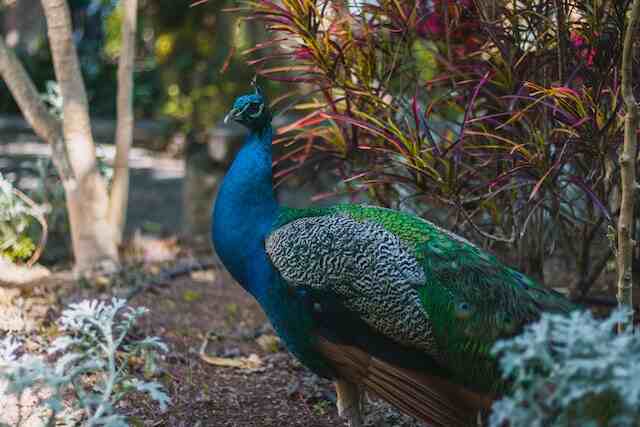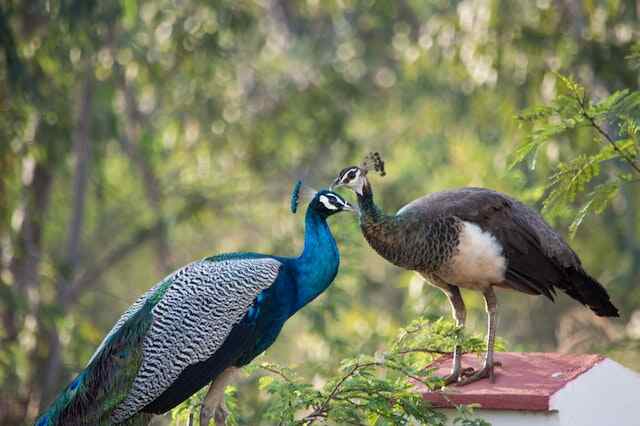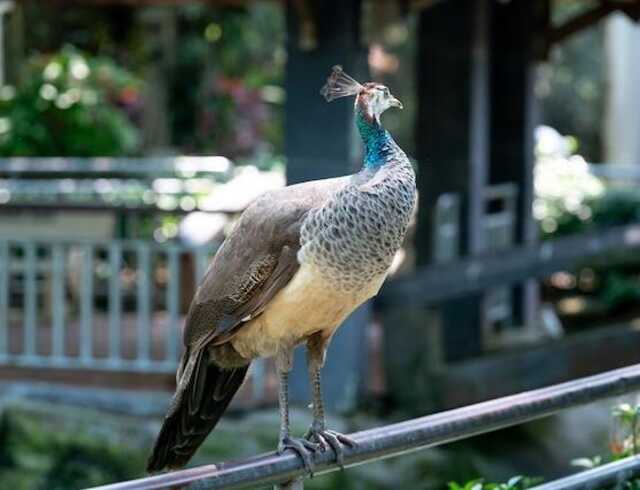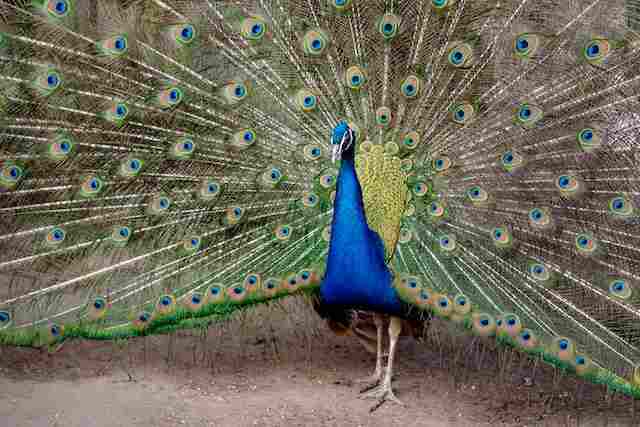Peacock enthusiasts and bird watchers alike often find themselves pondering the question: Where Do Peacocks Live? Well, let’s cut straight to the chase: these majestic birds are native to South Asia, but can now be found in various regions around the world.
But that’s just the tip of the peacock feather – keep reading to learn about their habitats, behaviors, and unique adaptations that make them one of the most fascinating creatures in the animal kingdom.
Table of Contents
- 1 Where Do Peacocks Live?
- 2 Peafowl Fact Sheet
- 3 Types of Peafowl
- 4 Natural Habits and Habitats
- 4.1 Peafowl Behavior and Communication
- 4.2 The Role of Peafowl in Their Ecosystem
- 4.3 Peafowl Feathers and Their Significance
- 4.4 Peafowl Vocalizations and Sounds
- 4.5 Peafowl Symbolism in Different Cultures
- 4.6 Peafowl Evolution and History
- 4.7 Peafowl Genetics and Breeding Patterns
- 4.8 Peafowl Natural Enemies and Defense Mechanisms
- 4.9 Peafowl Migration Patterns and Seasonal Movements
- 4.10 Peafowl Population Trends and Fluctuations
- 4.11 Peafowl Conservation Efforts and Success Stories
- 4.12 Peafowl Diseases and Health Concerns
- 4.13 Peafowl and Human Interaction
- 5 Peacock Habitat
- 6 FAQs About Where Do Peacocks Live?
- 7 Conclusion
- 8 Author
Where Do Peacocks Live?
Peacocks, known for their vibrant and stunning feathers, are found in a variety of environments. They prefer living in forested areas, but can also be found in agricultural fields and farms.
In some cases, these birds have even made their homes in suburban neighborhoods. Regardless of their location, peacocks are fascinating creatures and continue to capture the attention of bird enthusiasts worldwide.
Peafowl Fact Sheet
Peafowl are known for their vibrant colors and distinctive features, but they are also fascinating creatures with complex behaviors and interesting communication methods.
This fact sheet provides an overview of their natural habits, significance in different cultures, breeding patterns, and conservation efforts.
Size and Weight:
Peafowl’s size can vary, but they are generally large birds that can grow up to 5 feet in length, including their long, colorful tail feathers.
Adult males, called peacocks, can weigh up to 13 pounds, while females, called peahens, are usually smaller and weigh around 6 pounds.
Interestingly, the size of a peacock’s train is not indicative of its age or overall health, but rather its ability to attract a mate.
Appearance:
Peafowl are stunning birds with vibrant blue and green feathers and iridescent tail feathers that fan out in a distinctive train. The males have longer and more colorful tail feathers than the females, which they display in a spectacular courtship dance during breeding season.
Their train feathers can be up to 6 feet long, and they use them to create a visually stunning display to attract peahens. In addition to their showy plumage, peafowl also have a distinctive call that sounds like a loud “meow.”
Diet:
Peafowl are omnivores with a varied diet that includes insects, plants, and small creatures. They are opportunistic feeders and will eat whatever is available, including seeds, fruit, and small mammals.
Peafowl are known for their fondness for insects, which make up a significant portion of their diet. In addition, they have been observed consuming small reptiles and amphibians.
Habitat:
Peafowl are native to South Asia, and both the blue and green species inhabit open lowland forests, as well as farms, cultivated areas, and around Buddhist and Hindu temples.
These birds tend to inhabit deciduous forests and open wooded areas and can adjust to a range of environments, including rainforests and dry forests.
Peafowl are adaptable and have been introduced to many parts of the world, including North America, where they have established feral populations.
Geography:
Peafowl are the national bird of India and are native to countries such as Sri Lanka. They can now be found in many parts of the world, including North America, where they have been introduced.
They are popular in zoos and aviaries worldwide, and captive breeding programs have helped to maintain populations in many countries.
Breeding:
Peafowl breed during the rainy season, which is usually from March to June. Males use their colorful tail feathers to attract mates, and females lay eggs in a shallow nest on the ground. Peafowl are polygamous, and a male may mate with several females during breeding season.
Social Structure:
Peafowl are social birds that live in groups called parties. Males are usually dominant and will defend their territory and mates from other males. They establish a hierarchy based on their displays of dominance, with the most impressive males being at the top of the pecking order.
Lifespan:
Peafowl have a lifespan of up to 20 years in their natural habitat, but they can live even longer when kept in captivity. They are relatively long-lived for birds of their size, and their lifespan can be extended through proper care and nutrition.
Threats:
Peafowl face threats from habitat loss and hunting. They are also sometimes hunted for their feathers, which are used in traditional costumes and decorations. In some areas, they are considered pests and are culled to control their population.
Conservation Status:
Peafowl are not currently considered to be endangered, but their populations have declined in some areas due to habitat loss and hunting. Conservation efforts are focused on protecting their habitats and regulating hunting to maintain healthy populations.
Conservation Efforts:
Efforts are being made to protect peafowl populations by preserving their habitat and enforcing hunting regulations. Some organizations are also working to raise awareness about the importance of peafowl conservation.
In addition to their conservation efforts, there are also ongoing studies to better understand the behavior, ecology, and genetics of peafowl.
| Topic | Information |
|---|---|
| Size and Weight | Peafowl can grow up to 5 feet in length and males can weigh up to 13 pounds while females weigh around 6 pounds. |
| Appearance | Bright blue and green feathers, iridescent tail feathers that fan out, males have longer and more colorful tails. |
| Diet | Omnivores, diet includes insects, plants, and small creatures. |
| Habitat | Open lowland forests, farms, cultivated areas, and around temples. |
| Geography | Native to countries such as India and Sri Lanka, introduced to other parts of the world. |
| Breeding | Breed during the rainy season from March to June, males use colorful tails to attract mates. |
| Social Structure | Peafowl exhibit social behavior, males are dominant and defend territory and mates. |
| Lifespan | Can live up to 20 years in the wild and longer in captivity. |
| Threats | Habitat loss, hunting, and feather collection for traditional costumes and decorations. |
| Conservation | Efforts to protect habitat, enforce hunting regulations, raise awareness, and conduct research. |
Types of Peafowl
If you are curious about where peacocks live, it is important to understand the different types of peafowl. There are three main types of peafowl: blue peacocks, green peacocks, and Congo peacocks. Additionally, there are differences between male and female peafowl that are worth noting.
Blue Peacocks
Blue peacocks, also known as Indian peafowl, are the most common type of peafowl. They are native to India and Sri Lanka, but have been introduced to other parts of the world, including the United States.
Blue peacocks are known for their striking blue and green plumage, which is more vibrant in males than in females. They are also known for their long, colorful tail feathers, which can reach up to 5 feet in length.
Table for Blue Peacocks:
| Type of Peafowl | Blue Peacock |
|---|---|
| Native Region | India and Sri Lanka |
| Introduced to | Other parts of the world, including the United States |
| Striking Features | Striking blue and green plumage, more vibrant in males than females |
| Tail Feathers | Long, colorful tail feathers up to 5 feet in length |
Green Peacocks
Green peacocks, also known as Javanese peafowl, are native to Southeast Asia, including Indonesia and Malaysia. They are less common than blue peacocks and are known for their bright green feathers.
Like blue peacocks, males have more vibrant plumage than females. Green peacocks have a shorter tail than blue peacocks, but it is still quite impressive, reaching up to 3 feet in length.
Table for Green Peacocks:
| Type of Peafowl | Green Peacock |
|---|---|
| Native Region | Southeast Asia, including Indonesia and Malaysia |
| Striking Features | Bright green feathers, males have more vibrant plumage than females |
| Tail Feathers | Shorter tail than blue peacocks, up to 3 feet in length |
Congo Peacocks
Congo peacocks, also known as African peafowl, are native to the Congo Basin in Africa. They are the only type of peafowl that is native to Africa. Male Congo peafowl have blue and green plumage, similar to blue peacocks, but their tail feathers are shorter and more rounded. Females have reddish-brown feathers and lack the showy plumage of males.
Table for Congo Peacocks:
| Type of Peafowl | Congo Peacock |
|---|---|
| Native Region | Congo Basin in Africa |
| Striking Features | Blue and green plumage in males, shorter and more rounded tail feathers than blue peacocks |
| Female Features | Reddish-brown feathers, lack showy plumage of males |
Differences between Male and Female Peafowl
One of the most noticeable differences between male and female peafowl is their plumage. Males have more vibrant, showy feathers than females, particularly in the tail feathers.
Additionally, males are generally larger than females. However, both males and females have a distinctive crest on their heads. Another difference between male and female peafowl is their behavior.
Males are known for their elaborate courtship displays, which involve spreading their tail feathers and making loud calls. Females are more subdued and tend to be more focused on caring for their young.
Overall, understanding the different types of peafowl and the differences between males and females can help you appreciate these beautiful birds even more.
| Differences | Male Peafowl | Female Peafowl |
|---|---|---|
| Plumage | More vibrant, showy feathers, particularly in the tail feathers | Less vibrant, less showy feathers |
| Size | Generally larger | Generally smaller |
| Crest on head | Distinctive crest on head | Distinctive crest on head |
| Behavior | Elaborate courtship displays involving spreading tail feathers and making loud calls | More subdued, focused on caring for young |
Natural Habits and Habitats
In this section, we will explore the diverse natural habitats that peafowl inhabit, including lowland and deciduous forests, as well as tropical and dry environments. Understanding their natural habits is essential for their conservation.
Peafowl Behavior and Communication
Peafowl, or peacocks, are known for their striking appearance, with their iridescent feathers and long, colorful tails. However, they also exhibit interesting behavior and communication methods. In the wild, peafowl live in forested areas, as well as farms and agricultural fields.
They inhabit lowland forests, deciduous forests, and both tropical and dry habitats. Even in their natural range, these birds roam in cities and parks in search of food.
The Role of Peafowl in Their Ecosystem
Peafowl play an important role in their ecosystem. They are omnivores and eat insects, plants, and small creatures. They also help with seed dispersal and can control the population of certain insects.
Peafowl Feathers and Their Significance
Peafowl feathers are significant and play a role in the mating process. The males display their feathers in a fan-like manner to attract females. The feathers also provide insulation and protection from predators.
Peafowl Vocalizations and Sounds
Peafowl communicate through a variety of vocalizations and sounds. These include calls, screams, and grunts. Males also make a distinct “honk” sound during the mating process.
Peafowl Symbolism in Different Cultures
Peafowl are often seen as symbols of beauty, pride, and immortality in different cultures. In Hinduism, the peacock is associated with the god of war and is considered a sacred bird. The goddess Hera is linked with the peacock in Greek mythology.
Peafowl Evolution and History
Peafowl have a long history and have been found in fossils dating back to the Late Pliocene epoch. They are believed to have originated in Asia and have been domesticated for thousands of years.
Peafowl Genetics and Breeding Patterns
Peafowl have a complex breeding system and exhibit sexual dimorphism, where males and females have different physical characteristics. The genetics of their colorful feathers are also complex and involve multiple genes.
Peafowl Natural Enemies and Defense Mechanisms
Peafowl have a few natural enemies, including large predators such as tigers and leopards. They use their feathers and vocalizations to defend themselves, and can also run at speeds up to 16 kilometers per hour.
Peafowl Migration Patterns and Seasonal Movements
Peafowl do not typically migrate, but they may move seasonally in search of food and water. One of their notable traits is their adaptability, enabling them to thrive in diverse environments.
Peafowl Population Trends and Fluctuations
Peafowl populations have fluctuated over time due to habitat loss, hunting, and other factors. However, they are not currently considered endangered and have stable populations in many areas.
Peafowl Conservation Efforts and Success Stories
Conservation efforts have been made to protect peafowl populations, including habitat restoration and protection. Success stories include the reintroduction of peafowl into areas where they had previously disappeared.
Peafowl Diseases and Health Concerns
Peafowl can be affected by diseases like avian influenza and Newcastle disease, impacting their health. Preventive measures, such as regular health monitoring, vaccination, and biosecurity practices, are crucial for disease management.
Early detection and prompt intervention can reduce disease spread, prevent future outbreaks, and improve peafowl health. Awareness of peafowl health concerns and proactive steps towards their well-being are essential.
Peafowl and Human Interaction
Peafowl can have both positive and negative interactions with humans. They are sometimes kept as pets or used for their feathers, but can also cause damage to crops and gardens. In urban areas, they may become a nuisance due to their loud vocalizations and aggressive behavior.
| Topic | Examples |
|---|---|
| Natural Habits and Habitats | Forested areas, farms, agricultural fields |
| Role in Ecosystem | Omnivorous diet, seed dispersal, insect control |
| Feathers and Significance | Mating display, insulation, protection from predators |
| Vocalizations and Sounds | Calls, screams, grunts, “honk” during mating |
| Symbolism in Different Cultures | Beauty, pride, immortality, Hinduism, Greek mythology |
| Evolution and History | Originated in Asia, domestication for thousands of years |
| Genetics and Breeding Patterns | Sexual dimorphism, complex feather genetics |
| Natural Enemies and Defense | Predators such as tigers and leopards, feathers and vocalizations for defense |
| Migration Patterns and Seasonal Movements | Seasonal movement in search of food and water |
| Population Trends and Fluctuations | Fluctuations due to habitat loss, hunting, stable populations in many areas |
| Conservation Efforts and Success Stories | Habitat restoration and protection, reintroduction success stories |
| Diseases and Health Concerns | Avian influenza, Newcastle disease, preventive measures |
| Human Interaction | Positive interactions as pets, negative interactions as crop damage and urban nuisances |
Peacock Habitat
Peafowl, which includes both the blue peacock and green peacock, are native to South Asia, but they have been introduced to many other parts of the world. Peafowl can be found living in forested areas, farms, and agricultural fields in their natural habitat.
These creatures can be found in various habitats, including lowland forests, deciduous forests, and both tropical and arid regions. These birds are known to roam in cities and parks in search of food, even within their natural range.
| Habitat Type | Description |
|---|---|
| Forested Areas | Peafowl can be found in lowland and deciduous forests. They prefer areas with trees and dense vegetation. |
| Farms and Agricultural Fields | Peafowl are often seen on farms and in agricultural fields where they feed on insects, seeds, and crops. |
| Tropical Regions | Peafowl are native to South Asia, which includes tropical regions with high humidity and rainfall. |
| Arid Regions | Peafowl can also be found in arid regions with low rainfall, such as parts of Pakistan and India. |
| Urban Areas | Peafowl have adapted to living in urban areas, such as parks and gardens, where they search for food and shelter. |
Are There Wild Peacocks In North America?
While peafowl are not native to North America, they have been introduced in many parts of the continent. They have established feral populations in places like California, Florida, and Hawaii.
In some areas, they are considered pests because of their tendency to damage crops and gardens. However, many people enjoy having peafowl around their homes because of their beautiful plumage and unique personalities.
Peafowl Mating Rituals and Courtship Behaviors
During the breeding season, the male peacock displays his stunning plumage to attract a mate. He fans out his long, colorful tail feathers and struts around the female, making a series of calls and noises to get her attention.
If the female is interested, she will join the male, and they will engage in a series of courtship behaviors, including preening, wing flapping, and dancing. The male will also offer the female food and gifts, such as twigs and leaves.
Peafowl as Pets
Peafowl are popular pets because of their beauty and unique personalities. However, they require a lot of space and attention, and they can be noisy and messy.
If you are considering getting a peafowl as a pet, it is important to do your research and make sure you have the space and resources to care for them properly.
They also require a lot of socialization and interaction with humans, so they may not be the best choice for everyone.
FAQs About Where Do Peacocks Live?
If you’re interested in learning more about peafowl, you may have some questions about where they live, what they eat, and how they protect themselves. Below are some frequently asked questions along with their corresponding answers:
What is the lifespan of peafowl?
Peafowl can live up to 20 years in captivity, but their lifespan in the wild is shorter due to predation and other factors.
Can peafowl fly?
Yes, peafowl can fly, but they are not strong fliers and can only fly short distances. They usually prefer to run or walk on the ground.
What do peafowl eat in the wild?
Peafowl are omnivores and eat a variety of foods in the wild, including insects, plants, and small animals. They are ground-feeders and forage for food on the forest floor.
How do peafowl defend themselves from predators?
Peafowl have several defense mechanisms to protect themselves from predators, including their ability to fly short distances, their sharp talons, and their loud calls. They also have a behavior called “roosting,” where they gather in trees at night to avoid predators on the ground.
Are peafowl endangered species?
Peafowl are not currently considered endangered, but some species are threatened due to habitat loss and hunting. It is important to protect their natural habitats and avoid hunting them to ensure their populations continue to thrive.
Conclusion
In conclusion, peacocks are a fascinating species that can be found in various habitats around the world. Their ability to adapt to different environments, including urban areas, highlights their resilience and flexibility.
While they can exhibit aggressive behavior in captivity, they are generally peaceful animals that add beauty to their surroundings. As an ornamental bird, peacocks have been admired for centuries and continue to be a popular attraction in zoos and wildlife sanctuaries.
Whether you see them in their natural habitat or in captivity, peacocks are a sight to behold and offer a glimpse into the wonders of nature.
Related Post: The Anatomy of Peacocks: Understanding Their Features!








